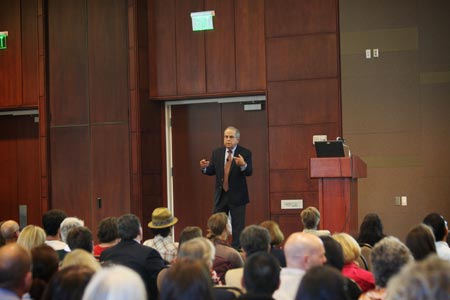
Northern Arizona University is leading the country in the innovation agenda during a “liberating” time for public higher education, according to a prominent authority who addressed the campus Wednesday.
George Mehaffy, vice president for Academic Leadership and Change at the American Association of State Colleges and Universities in Washington, D.C., spoke to about 180 faculty and staff gathered at the High Country Conference Center for his presentation on “Peril and Promise in a New Age.”
This “new age,” he said, is the result of power shifting away from traditional institutions of higher learning as students assert more control over where and how they take their courses, coupled with increased competition in the marketplace from start-up companies like Udacity and Coursera.
“We have a three-part problem,” Mehaffy said. “We’ve got to educate more students than ever before, we’ve got to educate them to much higher levels of learning outcomes and we’ve got to do it at a lower cost.”
He cited a number of critical challenges compounding the problem, including an 11th century educational approach that is “hideously expensive” and based on a funding model that is broken.
“Based on the trends since 1980, state support for higher education will reach zero by 2059,” he said. “In other words, we won’t have public institutions in this country any more.”
Perhaps most troubling, he said, is that “we are losing the public opinion battle” as more Americans question the value of a college degree and whether the education received is worth the cost.
Mehaffy said traditional course models that rely on individual faculty members to design a course, deliver the course and assess the course also are unsustainable. “You cannot get scale out of that proposition,” he said.
In spite of the challenges, though, Mehaffy sees opportunity and remains optimistic, calling this “the century of education,” during which more human beings will be better educated than at any time in the history of humankind.
“The only question left is, who will be the providers?” he asked the crowd. “For us to be the providers, we have to be willing to look at and examine and throw out everything.”
Mehaffy proposed that new course models—such as flipped courses, math emporiums, cross-institutional collaborations and blended courses—have shown improved learning outcomes, increased student/faculty interaction and instructional efficiencies, all of which is prompting institutions to quit thinking about courses and start thinking about experiences.
“When a student comes to NAU, particularly a residential student, it’s about the totality of the experience, and all of it ought to be intentional on your part,” he said.
Other areas where universities should focus their attention include using analytics to learn more about what makes students successful and to track course success; tailoring instructional materials and approaches to individual learners; reducing costs, from textbooks to clearing pathways to degree completion; defining and assessing learning outcomes as a measure of success; and exploring changes in administrative practices and faculty work.
Transforming the institution to give it a strategic advantage offers “enormous liberation” for faculty, students and others “who have been shackled by constraints of legacy systems,” Mehaffy said. But he cautioned that it will take a great deal of work.
“The challenge is enormous. We have a confusion of purposes, distorted reward structures, limited success, high costs, massive inefficiencies and profound resistance to change.”
The good news, he said, is that NAU is ahead of the game as a model for innovation. He applauded the “attention to evidence” that was on display in the room for an exhibition showcasing ways that faculty and departments are changing traditional institutional structures. But the work is far from finished. Each institution must identify its unique value. Likewise, he challenged attendees to consider the value they add to the institution.
“Leadership is not just the president,” he said. “A lot of people have to be leaders in order for an institution to truly be transformative.”
The ultimate question, he said, is whether that transformation can take place in time.
“This is not just a difficult moment. This is the dawn of a new era,” he said.



